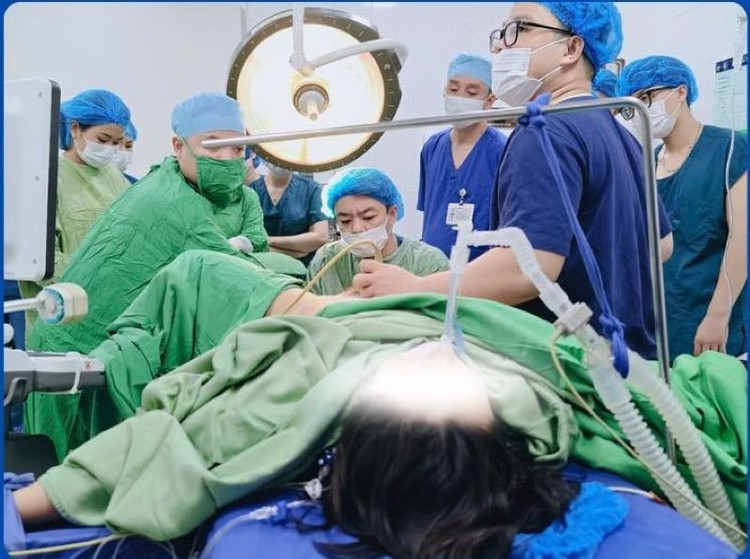Recently, Hanoi Obstetrics and Gynecology Hospital received a critical emergency case, a pregnant woman named Luong PA, 20 years old, from Hanoi , who was transferred from a lower level in a state of massive vaginal bleeding 12 days after giving birth naturally.
Upon admission, the patient was conscious, with pale skin and mucous membranes, obvious signs of anemia, blood pressure measured at 90/60 mmHg, and a rapid pulse of 100 beats/minute. Examination showed poor uterine contractions, a gauze pad in the cervix, and red blood flowing from the uterine cavity through the cervical canal into the vagina.
Ultrasound results detected an echogenic structure in the uterine cavity measuring 78x10mm. Blood test showed hemoglobin 82 g/l, hemtocrit 0.25 L/L.
Recognizing this as a case of late postpartum hemorrhage, the on-call team promptly implemented emergency treatment according to the protocol: Clean the uterine cavity, use uterine contraction drugs to stop the bleeding, and simultaneously transfuse 3 units of packed red blood cells, combined with broad-spectrum antibiotics.
However, bleeding continued, with an estimated volume of bright red blood of approximately 300 ml, indicating that blood was still being lost from a site with active blood vessels.

Due to the lack of improvement, the pregnant woman was transferred to the operating room for emergency treatment under the command of Dr. Do Tuan Dat, Head of Obstetrics and Gynecology Department and Dr. Luong Thi Ngoc Van, Deputy Head of Anesthesia and Resuscitation Department, along with the surgical team.
The team further identified the location of the bleeding from the cervical scratch, performed hemostasis, ligated the cervical arteries on both sides to control blood loss, and placed an intrauterine balloon.
The total amount of blood products transfused during and after surgery was up to 1050ml of packed red blood cells, 400ml of fresh frozen plasma, 400ml of cryoprecipitate (CRYO) - an indicator of severe blood loss and the risk of associated coagulation disorders.
After the intervention, the patient was stable and continued treatment and postoperative monitoring at department C3. The patient was discharged after 5 days of treatment.
Late postpartum hemorrhage – usually occurring 24 hours to several weeks after birth – is less common than early postpartum hemorrhage, but it develops silently and is unpredictable.
The cause may be retained placenta, uterine infection, blood clotting disorder or poor uterine contraction. The danger is that pregnant women are often subjective because they think they have "gone through the labor", leading to late detection.
The case of Ms. Luong PA is a warning. Early detection, standard treatment and timely surgical intervention helped save the life of this young mother.
Postpartum women, especially in the first days back home, if there are signs of prolonged or sudden vaginal bleeding that is more than normal, feeling tired, dizzy, or increasing abdominal pain, they need to go to a specialized obstetrics and gynecology facility immediately.
A mother's safety does not end after giving birth, but also depends on proper postpartum monitoring and timely examination when there are signs of abnormalities.
Source: https://khoahocdoisong.vn/nguoi-phu-nu-20-tuoi-nguy-kich-do-bang-huyet-muon-sau-sinh-post1553049.html



































































































Comment (0)